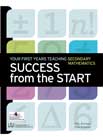Start Student Teaching Successfully!
Read more on how to implement these tips:
Stay connected and collaborate. Recognize that teaching can be both rewarding and challenging, and you're not alone in facing its ups and downs. Foster connections with fellow educators by joining online communities and professional networks tailored to teachers. Platforms like
MyNCTM,
Facebook, and
LinkedIn offer opportunities to exchange ideas, share successes and challenges, and access a wealth of resources and support from educators around the world. Engage in meaningful discussions, seek advice, and contribute to the collective knowledge base to enhance your teaching practice and promote continuous growth.
Establish open communication. Initiate a conversation with your cooperating teacher prior to your assignment to discuss your learning preferences, teaching style, and expectations. Offer to help decorate the room for a new year, topic, event, etc. Consider showcasing mathematical artwork of your students, such as tessellations, or post some
problems for students to think about. It will be helpful to exchange expectations in advance, so that you can both be sensitive to your differences. On the other hand, be yourself! Don't conform to who you think your supervising teacher wants you to be; rather, take advantage of the support that he or she has to offer as you mature into your own teacher. Check out NCTM's collection of Problems of the Week.
Stay informed and be proactive. Prepare yourself for student teaching by staying updated on current educational practices and resources. Explore a variety of instructional materials, including online platforms, educational blogs, and professional development websites. Offer lesson suggestions and ideas to your supervising teacher, demonstrating your proactive approach to student engagement and learning. Advocate for your students' learning by actively seeking out innovative teaching strategies and resources that align with their needs and interests. Advocate for your students' learning by actively seeking out innovative teaching strategies and resources from platforms like
NCTM Illuminations.
 Co-create an observation schedule and discuss essential non-content items. Discuss observation goals and desired frequency with your supervising teacher early on to ensure clarity and maximize the benefits of your time together. This avoids misunderstandings about your role in the classroom and ensures productive observations. Additionally, set aside time to discuss important non-content items with your mentor teacher or administrator. These discussions should cover grading policies, the grading platform, and the workflow platform. Clarify expectations for updating the grade book and understand the school's behavior policies, including rewards and consequences. These non-content areas significantly influence how you teach. For example, understand if students can make up credit on exams and the procedures for retakes. This might require planning multiple versions of exams or designating specific days for make-ups and enrichment activities. Determine if retakes can be scheduled during class, after school, or during homeroom, and how to manage instructional time effectively.
Co-create an observation schedule and discuss essential non-content items. Discuss observation goals and desired frequency with your supervising teacher early on to ensure clarity and maximize the benefits of your time together. This avoids misunderstandings about your role in the classroom and ensures productive observations. Additionally, set aside time to discuss important non-content items with your mentor teacher or administrator. These discussions should cover grading policies, the grading platform, and the workflow platform. Clarify expectations for updating the grade book and understand the school's behavior policies, including rewards and consequences. These non-content areas significantly influence how you teach. For example, understand if students can make up credit on exams and the procedures for retakes. This might require planning multiple versions of exams or designating specific days for make-ups and enrichment activities. Determine if retakes can be scheduled during class, after school, or during homeroom, and how to manage instructional time effectively.
Collaborate with students and build relationships. As you become more comfortable in the classroom, start incorporating collaborative activities and rotations to help build relationships with students, establish their trust, and reduce anxiety as you transition from observation to teaching. Use digital tools to facilitate group work and encourage peer-to-peer learning and consider using technology to facilitate student collaboration and feedback, such as digital whiteboards or online discussion boards. Additionally, incorporate flexible and adaptive seating arrangements to encourage student movement and engagement, and use differentiated instruction and scaffolding strategies to support diverse learning needs. By incorporating these teaching practices, you can create a more inclusive and engaging learning environment that promotes student agency and autonomy.
Prioritize self-care. Student teaching can be demanding, so it's crucial to prioritize your well-being. Establish healthy routines for sleep, exercise, and balanced nutrition. Explore self-care practices like mindfulness or relaxation techniques to manage stress. Taking care of yourself will allow you to be at your best for your students and your learning experience.
Develop a system for lesson planning and organization. Juggling lesson plans, grading, and student data can feel overwhelming during student teaching. To stay on top of it all, develop a system for lesson planning that works for you. This could be a template you fill in or a step-by-step process you follow. Additionally, implement organizational strategies for paperwork, grading, and student data. Binders, color-coding, or digital tools can all be helpful. Remember, you don't have to go it alone! If you're feeling overloaded, don't hesitate to ask your cooperating teacher, colleagues, or school administration for help. A little planning and collaboration can go a long way in keeping you organized and focused throughout your student teaching experience.
Cultivate a positive learning environment. Effective classroom management is key for a successful student teaching experience. Instead of just reacting to student behavior, focus on proactive strategies. Collaborate with your cooperating teacher to establish clear and consistent expectations for the classroom. Understand your school's specific policies and guidelines so you can operate within the parameters while adding your personal touch. Prioritize positive reinforcement by acknowledging and rewarding students who follow the rules. Develop a plan for addressing disruptive behavior that includes strategies like redirection, offering choices, or providing support for struggling students. Explore restorative practices that focus on repairing harm and building relationships rather than punishment. Remember, effective classroom management should be inclusive and responsive to the needs of all learners.
Arrive prepared and ready to learn. Demonstrate professionalism by consistently arriving at school before the designated start time. This allows you to get organized, review lesson plans, and greet students as they enter the classroom. This shows respect for your cooperating teacher and the students and sets a positive example for future classroom management.
Establish a strong connection with students and parents/guardians from the start. Before the school year begins, prepare a personalized introduction letter or email to students and parents/guardians. Share your passion for teaching, your educational background, and your goals for your student teaching experience. Highlight your unique strengths and interests to show your enthusiasm for working with students. Consider adding a personal touch by sharing a fun fact or two about yourself. Have your supervising teacher review the letter to ensure it is professional and effective. Sending out this introduction early on sets the tone for a positive and collaborative relationship with students and parents and helps establish trust and open communication lines.
Dress for success. As a student teacher, you want to make a strong and professional impression on your students, colleagues, and supervising teacher. While comfort is important, remember that you're now part of a professional environment. Aim for a balance between professional, comfortable, and stylish – you can still look great while maintaining a professional image. Just look nice, be clean, and ensure you maintain good hygiene. Depending on the grade level you teach, you may need to move around a lot with your students. By dressing appropriately and comfortably, you'll show your commitment to your role and set yourself up for success in your student teaching experience.
Build connections beyond the classroom. Take time to get to know the office staff, custodial crew, and other members of the school community. These individuals play a vital role in the smooth operation of the school and can be a valuable source of support. A friendly greeting on your way in can go a long way. They might be able to alert you of important announcements or offer helpful advice if you need something outside the classroom. Building positive relationships with everyone in the school fosters a collaborative and supportive environment for both you and the students.
Integrate your passions for engaging learning. Don't be afraid to share your interests and hobbies with your students! This can be a fantastic way to build rapport and create engaging learning experiences. However, focus on incorporating your interests in a way that aligns with the curriculum and allows for student choice. For example, if you're an artist, you could offer students a variety of artistic approaches to represent mathematical concepts. If you love football, explore how math and physics are applied in the sport and allow students to choose projects related to their own favorite sports. This personalized approach demonstrates your passion while ensuring students are actively involved in their learning.
Invite the principal to watch a lesson that you are excited about. Discuss the possibility of inviting the principal to observe a lesson you've co-created with your cooperating teacher. This demonstrates your collaboration skills, initiative, and confidence in your teaching abilities. Having both your cooperating teacher and the principal observe a lesson can provide valuable feedback for your development. Once you've received feedback, politely inquire about the possibility of them writing you a recommendation upon completion of your student teaching. Their positive observations can be a valuable asset in your job search.
Explore professional development opportunities with your cooperating teacher. Beyond attending workshops or conferences offered by your school or district, consider collaborating with your cooperating teacher to explore professional development options. This could involve attending
online webinars, joining subject-specific online communities, or reading educational blogs together. Consider attending
NCTM conferences to connect with other teachers and explore resources that cater to your specific teaching interests and grade level. Discussing these options with your cooperating teacher allows you to discover shared learning experiences and fosters a collaborative learning environment.
Maintain professional confidentiality and respect. When interacting with colleagues, be mindful of the confidentiality of students and teachers. You may not always know the personal relationships or circumstances surrounding students, so it's essential to be respectful and tactful in your conversations. Avoid sharing negative or potentially sensitive information about students or teachers, even if it's just a casual chat. When discussing your own experiences, focus on the lessons learned and the impact on your teaching practice rather than sharing personal anecdotes or gossip. Additionally, refrain from participating in gossip or rumor-spreading in the staff lounge or elsewhere. By maintaining a professional and respectful attitude, you'll build trust and credibility with your colleagues and demonstrate a commitment to professionalism and integrity.
Express gratitude and build your network. As you complete your student teaching experience, take the opportunity to express your gratitude to those who have played a significant role in your learning journey. Write thank-you letters or emails to your supervising teacher, principal, and any other educators who have supported you along the way. These relationships can be invaluable in your future teaching career, providing a valuable network of mentors, peers, and confidants who can offer guidance, advice, and support. By nurturing these relationships, you'll be able to maintain a sense of community and connection within the education profession. Remember, these connections can be a valuable resource for addressing questions, sharing best practices, and navigating the challenges and triumphs of teaching.
Project positive energy. A positive demeanor goes a long way in creating a welcoming and supportive classroom environment. This includes maintaining a friendly and approachable attitude with your students, colleagues, and school staff. Smiling is a great way to project positive energy, but remember, genuine warmth and approachability are key.
Related Publications:

